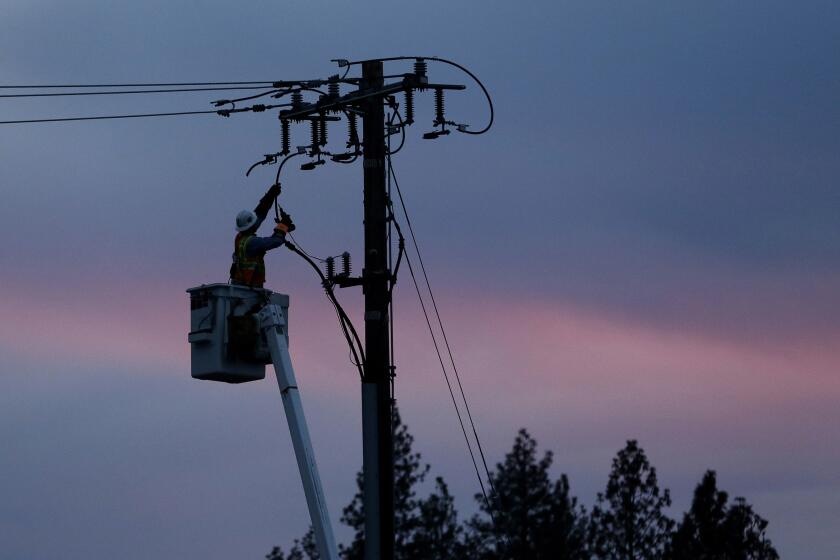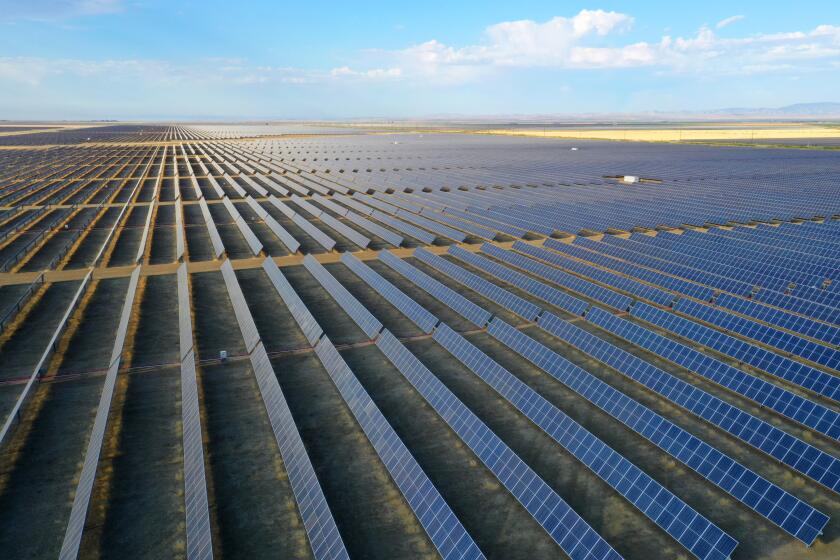
- Share via
- Financial credits to owners of rooftop solar panels that generate more power than the home needs can greatly lower electric bills. But as more people have been motivated to install the panels, it has cut into utility sales of electricity.
- State officials say rooftop solar customers don’t contribute their fair share of costs to maintain the power grid, but environmentalists say strong incentives are needed to convince homeowners to invest in costly rooftop solar panels.
California officials are pressing for further cuts to the electric bill credits people with rooftop solar panels can earn, in a move that would align the state with its for-profit utilities at the expense of consumers who invested thousands of dollars to power their homes with renewable energy.
Southern California Edison, Pacific Gas & Electric and San Diego Gas & Electric have long complained about the financial credits to households that generate more solar energy than they can use — credits that can keep rising electricity costs in check for those with panels.
But the energy generated by rooftop solar also puts a dent in utility sales of electricity, and the big utility companies successfully pressed the state Public Utilities Commission in 2022 to reduce the value of the billing credits for panels installed after April 15, 2023.
Now, the credits for consumers who installed panels before that date are becoming a target.
The commission staff, with the support of its consumer-focused Public Advocates Office, is making a case for cutting credits to those who installed rooftop panels before April 2023. Those panel owners are paid the retail rate for the excess electricity they send to the grid, while later adopters are paid a fraction of that price.
Among the ideas floated in a report by commission staff last week is to limit the number of years those customers can receive the retail rate, or end it when a home is sold. The commission staff also suggested adding a new monthly charge to solar owners’ bills, saying it would reduce the costs needed to maintain the electrical grid that it says are shifted to other customers.
The report, issued in response to last fall’s executive order by Gov. Gavin Newsom calling for recommendations to stem rising electric rates, comes after a series of reports from the Public Advocates Office critical of how people with solar installations are compensated for the excess solar power they generate.
“Rooftop solar customers do not contribute their fair share of fixed grid costs, such as maintaining power lines and ensuring grid reliability,” the advocates office said in a December report. “These costs are shifted onto non-solar customers, who shoulder a disproportionate financial burden.”
Any action to cut the electric bill credits would have to be approved by the state Public Utilities Commission. Municipal utilities such as those in the cities of Los Angeles, Glendale and Pasadena aren’t affected by its decisions.
Rooftop solar advocates and environmentalist groups say that strong incentives are needed to encourage people to spend thousands of dollars on rooftop systems that help wean California off fossil fuels.
“It’s the utilities preserving their monopoly,” said William Anastas, a resident of Long Beach, who paid nearly $18,000 to install the panels on his home in 2018. “This is fixed against us. They will get their way.”
With little public debate, state lawmakers passed a complex energy bill that upended how most Californians are billed for electricity.
The commission and the advocates office blame rooftop solar payments as a major reason for California’s fast-rising electric rates, but critics point to other factors.
Utilities such as Edison, PG&E and SDG&E make much of their profit not by selling more electricity, but by building infrastructure, such as the towers and lines needed to link solar farms far from cities to the grid. On its website, for example, PG&E notes that regulators want to encourage customers to conserve power, so as a result the company “does not make more money when customers use more energy.”
Economist Richard McCann performed an analysis for the rooftop solar industry that found electric rates had risen as the utilities spent more on infrastructure.
Even though homeowners’ solar panels helped keep public electricity demand flat for 20 years, the three companies’ spending on transmission and distribution infrastructure increased by more than 300%, according to McCann, who works for the public policy consulting firm M.Cubed.
Much of that spending, which led to rate increases, was approved by the state’s Public Utilities Commission. The five-member panel appointed by Gov. Gavin Newsom has long been faulted for favoring utilities over customers, and those complaints have been heightened in the wake of the Eaton and Palisades fires.

Less than two weeks after the fires began last month, for example, the commission approved Edison’s wildfire mitigation plan even though regulators had detailed myriad problems with how the company was trying to keep its equipment from sparking fires.
Then on Jan. 30, the commission overrode objections from the public and voted to raise Edison’s electric rates so that customers would cover most of the payments made to victims of the 2017 Thomas fire, which according to investigators was ignited by company equipment. After the vote, seven Democratic state legislators sent a letter to the commission, saying the action harmed customers and failed to hold Edison accountable.
“They’re letting utilities treat ratepayers as an ATM,” said Bernadette Del Chiaro, former executive director at the California Solar & Storage Assn., which represents companies selling rooftop systems.
California Public Utilities Commission spokeswoman Terrie Prosper disputed that contention. The commission estimates that the rooftop panels are adding 11% to 25% to the electric bills of customers who don’t have them, she said, while not significantly reducing the need for spending on poles and other grid infrastructure.
“While rooftop solar panels can in theory avoid some transmission costs,” Prosper said, “many transmission costs — such as infrastructure upgrades to mitigate wildfire risk — cannot be avoided.”
Edison supports solar power, said Dan Hopper, the utility’s managing director of regulatory policy, but asked state officials to reduce the rooftop incentives because the program was resulting in electrical grid costs “being pushed onto other customers that don’t have solar.”
“We’re concerned about that sort of inequity,” Hopper said. “It’s an inaccurate statement, from my perspective, to say it’s about utility profits.”
PG&E and SDG&E declined to make executives available for comment.
California’s electricity rates are now the second highest in the nation and have increased significantly faster than those in the rest of the nation, the nonpartisan Legislative Analyst’s Office said in a recent report.
Although general inflation increased by about 18% from 2019 to 2023, the analyst said, rates charged by the three utilities have climbed 48% to 67%.
At the same time, the companies continue to post big profits. PG&E said this month that it earned a profit of almost $2.5 billion in 2024, up 10% from the year before. Edison and SDG&E will report 2024 results later this month. In 2023, the parent of Edison recorded $1.2 billion in profit — a jump of 95% from the year before. SDG&E made $936 million in 2023, up from $915 million in 2022.
California is now producing so much solar energy that the state must increasingly ask solar farms to stop producing to prevent overloading the electric grid. In the last 12 months, power that would have fueled 518,000 California homes for a year has been curtailed or thrown away.
The solar threat
The electric utility industry has long recognized the threat posed by rooftop solar.
David Owens, an executive with the Edison Electric Institute, an industry trade group, noted during a 2012 conference that California state officials had given nearly $2 billion in incentives to homeowners installing rooftop solar panels, which meant declining electricity sales for the utilities.
“How do you grow earnings in this environment?” he asked, according to slides in his presentation.
Under California’s system, rooftop solar owners get a credit on their electric bills for the solar energy they don’t use and send to the grid. The credit was based on the current retail electric rate for each utility, which grew in value as the state’s Public Utilities Commission approved rate increases requested by the companies.
In January 2016, the state’s utility commissioners, who had been appointed by Gov. Jerry Brown, voted 3 to 2 to keep paying new rooftop solar customers retail rates for energy they sent to the grid.
That year, the Edison Electric Institute revealed at an executive meeting that it had hired a New York public relations firm, Maslansky and Partners, to polish the utility companies’ public image, as reported previously by the Huffington Post.
The plan, called the Lexicon Project, suggested that utility companies describe rooftop panels as “private solar” that “benefits only a limited number of owners” and raises costs for others.
When the California PUC took up the rate issue again five years later, the utilities emerged as part of a new coalition called Affordable Clean Energy for All that painted rooftop solar as benefiting the wealthy.
“Rooftop solar is adding to income inequality,” said one of the coalition’s social media advertisements.
Whether that is the case continues to be debated. Statistics from the Lawrence Berkeley National Laboratory show that 39% of the owners of the rooftop panels in 2023 had household incomes of less than $100,000. About 12% had incomes below $50,000.
The Times and others detailed how two-thirds of the community groups that had joined the coalition had received money from the state’s utilities.
That financial support, and the fact that the three utilities had paid to create the Affordable Green Energy for All coalition, weren’t always disclosed in the coalition’s public announcements.
The utilities say they followed laws in disclosing their funding. “The coalition’s website clearly showed how it was financially supported,” PG&E said in a statement.
In December 2022, the California commission voted unanimously to reduce financial incentives that homeowners could receive from the panels by about 75%, starting with those purchasing the systems on April 15, 2023.
The commission estimated that homeowners installing the systems after that date could still save about $100 on their bill each month and pay off their systems in about nine years.
The homeowners also can continue to get a 30% federal tax credit on their rooftop systems, which was extended by the Biden administration for the next decade.
The commission said its new rooftop program “controls electricity costs and improves electric bill affordability for all Californians.”
California officials voted to let Southern California Edison raise electric rates to cover payments it made to victims of the 2017 Thomas wildfire.
Environmentalists are trying to overturn the 2022 decision in court.
The Center for Biological Diversity, the Environmental Working Group and the Protect Our Communities Foundation say the commission has not considered certain benefits of the solar panels. Among those, the groups say, is how they reduce greenhouse gases and can limit the amount of land cleared for industrial-scale solar farms.
A state appeals court ruled in late 2023 against a lawsuit brought by the groups. They then took the case to the state Supreme Court, which agreed to hear their arguments. No date for that hearing has been set.
Roger Lin, an attorney for the Center for Biological Diversity, said the groups question whether the rooftop panel incentives are actually shifting costs to those without the systems.
“There are so many other drivers of high electric bills,” he said, including the rate increases for infrastructure that the companies asked the commission for approval to build.
“It’s like the utilities are saying, ‘Don’t look here, look over there,’“ Lin said.










